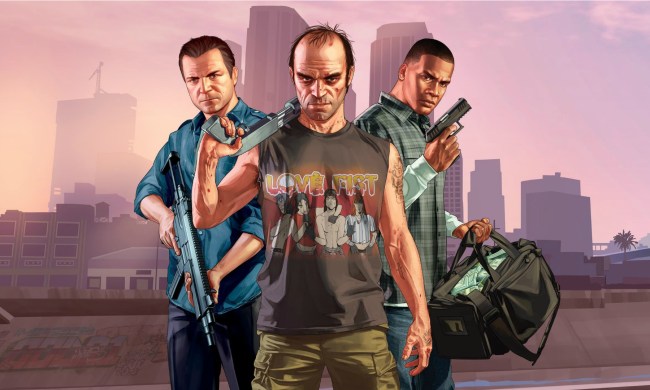 The recent outcry about the supposed “sexual assault” theme in the new Tomb Raider game, which was previewed at E3, has thrown up a familiar prejudice. For some reason, mainstream video games can’t have any sexual content without it causing a huge fuss. Movies and TV shows are frequently packed with all manner of sexual scenes. Advertising bombards us with images that would have been considered pornographic a few decades ago. Why are games subjected to a different standard?
The recent outcry about the supposed “sexual assault” theme in the new Tomb Raider game, which was previewed at E3, has thrown up a familiar prejudice. For some reason, mainstream video games can’t have any sexual content without it causing a huge fuss. Movies and TV shows are frequently packed with all manner of sexual scenes. Advertising bombards us with images that would have been considered pornographic a few decades ago. Why are games subjected to a different standard?
Within hours of the new Tomb Raider trailer screening, the Internet was awash with articles condemning the use of rape as a plot device in games. My Twitter feed was bursting with debate on the topic. I had to take a look for myself. You should do the same, here it is. Ok, back now? So why all the fuss? I’ve read some strange attacks on the developers, and admittedly their denial that it’s an attempted rape scene is probably misjudged – it clearly is. The question is: Why is that a problem?
I don’t see any hint that the game is glamorizing rape. The men attempting to assault her are clearly the baddies. You may well find the use of a sexual assault threat to be distasteful, and there’s no arguing it’s a pretty obvious way to create vulnerability in a character, but does it really deserve all the vitriol?

Sexual assault is clearly a thorny issue, and it should be treated with respect. As a society we should be doing more to reduce it, but I don’t see how censoring it is going to achieve that aim. I can understand irritation at the way female characters are portrayed by a male-dominated game development community. Women are often objectified — Lara Croft is a prime example — but the perception that gamers are all young men is surely dead now. I don’t see any evidence in the trailer that they are belittling the issue of sexual assault. Even if they were, why is that so much worse than the lurid descriptions and explicit scenes that permeate the rest of our entertainment?
The truth is that when it comes to video games, there is a double standard at work. Violence is okay, sex is not. Let’s move on from the assault issue and take a look at the world of consensual sex in games.
If you cast your mind back a few years to the “Hot Coffee” mod for Grand Theft Auto: San Andreas you’ll remember the fuss it caused. The game rating was upgraded from Mature to Adults Only and a number of major retailers actually pulled it from their shelves. This was all because of a mini-game which allowed the protagonist, CJ, to have sex with his girlfriend. The mini-game required a hack to unlock, and featured fairly crudely modelled characters having sex (CJ was fully clothed throughout). The player could control some of the actions.
This is a game in which you can shoot police in the face, have sex with prostitutes (but not see it) and then beat them to death or just randomly run over innocent people in the street. How could a simple consensual sex scene provoke such outrage?

There is definitely a generational issue at work. Some people cannot get their heads around the idea that video games are not just for kids. This perception leads to shock and outrage at mature content and misses the point that it is not intended for children. Violence is tolerated just as it is in classic cartoons like Tom and Jerry, but sexual content is not acceptable.
Age ratings are there for a reason — if retailers and parents fail to enforce them that is not the fault of the developer. California tried to regulate this by classifying games in the same way they classify porn, but the Supreme Court overruled this. Let’s face it, no one wants to live in a world where the only entertainment allowed has to be deemed suitable for children.
Could it also be that some people feel the interactive element makes things more serious? It’s fine to passively sit and watch scenes of a sexual nature on the television, but if you are in some way participating then it’s dangerous. The anti-violent games lobby has certainly been looking for a link between playing violent games and increased aggression for years, even decades. Perhaps the fear is that sexual games will lead to increased sexual activity.
Most of the people who are quick to criticise and condemn never actually play the games they are discussing. That’s what seems different about this latest Tomb Raider outrage. Many gamers are condemning it vehemently.
Perhaps the weight of years of casually sexist renderings of female characters has finally taken its toll. As a man, I’m sick and despairing of the way women are portrayed in some video games. The obviously pointless nature of armor that only covers your crotch and chest, the frequency with which females are simply damsels in distress or trophies to be won, and the lack of female protagonists who aren’t designed to appeal to a male audience are all lamentable clichés. But why are games held up to a higher standard than every other entertainment medium?
Can you imagine any fuss over a fully clothed sex scene in a TV show or a lurid description of a sexual assault in a women’s magazine? What makes games different?


